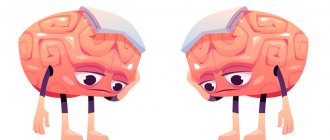Cognitions
Cognition (from Latin cognitio) is “a generic term used to designate all processes involved in the acquisition of knowledge,” states Ernest R. Hilgard in Consciousness in Modern Psychology. This term covers all mental activities or states associated with the acquisition of knowledge and the functioning of the mind.
Cognition is a general concept that covers all forms of knowledge, including perceptual images, logical evidence and value judgments; the process of a person’s cognition of the world and himself, through which information is processed. It includes the level of sensations, the level of perception, attention, memory, the level of ideas and the level of thoughts. It is based on the client's beliefs, attitudes, expectations, ideas, perceptions, opinions and way of thinking.
In cognitive psychotherapy, the following cognitive structures and processes are distinguished: beliefs, attitudes, rules, expectations, attitudes, assumptions, automatic thoughts, schemas, systems of action and control. The content of the cognitive sphere is constantly changing. Cognitive changes occur at three levels:
- in voluntary thinking (thoughts can be caused at will, and they are temporary);
- in automatic thinking (thoughts arise involuntarily, they are temporary);
- in assumptions (beliefs).
These levels differ from each other in stability and accessibility for analysis.
Varieties
Now let's figure out what mental processes are.
Basic (lower) cognitive processes
They are presented:
Feeling and perception
We are constantly exposed to various stimuli and signals that make us feel something. Feelings serve as an additional tool for understanding the surrounding reality. Moreover, they can come both from outside and from the depths of ourselves.
Gestalt psychologists, who are engaged in a detailed study of human perception of the world, made a great contribution here. They came up with the laws of Gestalt, which explain the perception of what is happening through optical illusions.
Attention
We live in a world of information and receive many signals and stimuli every day, while paying attention to what we are most interested in.
For a number of activities, such as walking or chewing, we do not need attention. But we will need greater concentration on what we say and how we present it, if, for example, we have to speak in public.
The positive thing is that when certain processes are repeated systematically, they become automatic. For example, if at first it’s difficult for us to drive a car, then later the skills are improved and performed “automatically,” thanks to which much less energy is wasted.
By memory
Our memory stores answers to countless questions that arise in life. It is thanks to it that we encrypt information received from outside and store it so that it can be restored when necessary.
Memory can be of different types: sensory, short-term, working, autobiographical, and so on. All of the varieties interact with each other, but they all originate in different parts of the brain.
Higher (complex cognitive processes)
They are presented:
Mind (intellect)
Intelligence is a set of abilities that help in solving various problems. Nowadays, the most popular theory is about multiple intelligences, which was proposed by Gardner. According to it, there is no one type of mind, and in different situations a person uses different abilities, starting from what is happening.
Smart people have a number of specific identifying characteristics. But intelligence can be improved; there are several methods for this.
Thinking
Human thoughts are incredibly complex and diverse. Thanks to thinking, we can solve various difficulties, reason, make decisions, think creatively, logically, and so on.
To simplify these processes, thoughts with judgments are created in our brain. Our task is to group ideas, objects, people, etc., which has an accelerating effect on mental processes.
But in the desire to achieve logic, a person often forgets about his irrationality. Just think - to speed up thinking we use shortcuts, but in the end we don’t analyze all the information! As a result, cognitive biases and deviations from the norm arise.
Due to cognitive biases, cognitive distortions, negative and irrational thoughts develop, which cause a lot of suffering. For example, “nobody loves me”, “I will always be lonely” and so on.
Fortunately, a person has power over his own thoughts, but not everyone is aware of it and not everyone knows how to use it correctly.
Speech
The human brain reproduces and understands different words, sounds, and combines an innumerable number of letters with sentences to express our thoughts and emotions. Some people speak several languages at the same time (polyglots).
Speech develops and improves throughout life. Although we are all born with different communication skills, they can improve with practice. The latter is especially important for people with speech disorders, because they can also be, if not completely eliminated, then at least reduced.
Automatic thoughts
Automatic thoughts are less accessible to awareness than voluntary thoughts, but they are not as deeply buried as attitudes and patterns. Automatic thoughts are an analogue of what S. Freud defined as “preconscious thinking” and what A. Ellis calls “self-declarations.” Automatic thoughts are verbal formulations or images; they are the most superficial level of cognitive activity. They appear spontaneously and precede emotions and behavioral reactions. Automatic thoughts reflect the content of schemas—deeper beliefs and assumptions. In the presence of psychopathology, some automatic thoughts are characterized by the presence of specific systematic errors in information processing (cognitive errors, cognitive distortions).
As you read these lines, you may notice that many thoughts arise at once. Part of your consciousness is focused on obtaining new information, that is, you are trying to understand the text. This is voluntary thinking. At the same time, you are visited by fleeting evaluative thoughts. These are called automatic thoughts; they are not the result of reflection, inference, and are not necessarily supported by evidence. On the contrary, these thoughts appear as if on their own, often they are short and fragmentary. It is likely that, without being aware of their presence, you are aware of the emotions that follow these thoughts.
People tend to accept their automatic thoughts as truth. However, you can learn to recognize automatic thoughts by paying attention to changes in your emotional state. To become aware of the automatic thoughts that trigger negative emotions, you can ask yourself, “What did I just think?”
Once you've learned to recognize automatic thoughts, you can take the next step: assess their validity. If the client understands that his interpretations are wrong and changes them, then his mood improves. It can be argued that when dysfunctional thoughts can be rationalized, emotions usually change as a result.
Characteristics of automatic thoughts:
- They are part of people's internal monologue, and reflect what people tell themselves.
- They can take the form of words, images, or a combination of words and images.
- They arise spontaneously, not as a result of reflective or motivated thinking, deliberation or reasoning. A person makes no effort to cause them. They do not have a logical sequence of steps, as in goal-oriented thinking or problem solving.
- They simultaneously coexist with a stream of more distinct thoughts.
- They are fleeting, brief, specific, separate, fragmentary and appear in shorthand form.
- They are not expressed verbally, but affect tone of voice, facial expression, gestures and behavior. They precede the appearance of emotions. Depending on their content and meaning, automatic thoughts are associated with specific emotions.
- As a rule, they are perceived as plausible and regarded as true without reflection or critical evaluation, they are not tested for logic and realism. But they can distort a person’s perception of reality and prevent them from achieving their goals.
- They occur very quickly and are usually on the verge of awareness. Often they go completely unnoticed. At the same time, the emotion associated with them is recognized better. They can be difficult to identify, but counselors can teach clients to identify these thoughts with great accuracy.
- One can learn to be aware of them, to evaluate their validity and usefulness. Automatic thoughts can be assessed according to the criteria of reliability and benefit. A rational response to automatic thoughts usually produces a positive affective shift.
- They are difficult to turn off and tend to come back despite people trying to block them.
Sensorimotor stage (birth to 2 years)
The first stage is called sensorimotor because at this stage children have a special connection between motor (motor) activity and thinking (sensory perception). At this stage, babies master various motor skills - grabbing, holding on to objects, throwing, crushing, hitting, etc. In the process of such actions, they comprehend how objects behave and what will happen if they are treated this way.
The child begins to realize himself as a bearer of action, as well as the fact that he is a separate subject. He notices the result of his actions and learns to act voluntarily, with the intention of obtaining a certain effect. For example, an infant shakes a rattle to make a sound.
The most important discovery at this stage is the concept of object permanence - the child learns that an object continues to exist, even if it becomes inaccessible to the senses, i.e. invisible or out of sight. Thus, children aged 5 to 8 months discover that even if a toy is hidden, for example, under a blanket or behind something, then, although it is not visible, it is there and can be taken. However, a child about a year old will still look for the toy where he last found it, and not where he saw it hidden.
To better understand what this looks like, watch this short video in English showing children's varying abilities to understand the principle of object permanence.
Another significant phenomenon observed around the same time in children at the sensorimotor stage of development is fear of strangers. It is caused by the fact that the child is not able to assimilate strangers and strangers into his existing schemes.
The first stage of development, spanning ages from birth to about 2 years, is followed by the preoperational stage.
Beliefs (attitudes)
Beliefs are a deeper and more stable cognitive phenomenon.
Starting from childhood, people strive to understand the world around them. In order to adapt and organize their experience into a certain system, they look for logical relationships in what is happening to them. Interaction with the world and other people leads to the formation and assimilation of certain conclusions.
This is how people form certain beliefs about themselves, the people around them and the world as a whole. The most important, or deepest beliefs are attitudes that are so deep and fundamental that people often cannot clearly express them, or even simply realize them. The bearer of such ideas regards them as pure truth simply because that is how it “is.” This belief may only affect that person when they are depressed or active most of the time. When this deep view is activated, a person interprets everything that happens to him through the prism of this belief, despite the fact that, from the standpoint of common sense, the corresponding explanations may be frankly erroneous. In this case, a person may tend to take into account only information that confirms his core belief, ignoring or undervaluing information that contradicts it. This is how he maintains his core belief, even if it is wrong and dysfunctional.
Deep (basic) beliefs
Deep (basic) beliefs are a person’s key ideas about himself (self-concept), this is the fundamental level of beliefs; they are pervasive, ingrained and difficult to change, and overgeneralized.
All core beliefs can be divided into three categories: helplessness (for example, “I cannot exercise control”), rejection (for example, “I have a flaw, therefore I am unwanted”) and incompetence (for example, “I am inferior”). Some core beliefs fall into more than one category at once.
Deep beliefs in the category of helplessness include both beliefs in personal helplessness (powerlessness, vulnerability, limited means, inability to control the situation, weakness, neediness) and inadequacy of others in the sphere of achievements (failure, failure, inferior, incapable, good for nothing, Jonah). For example:
I'm unsuccessful. I'm not capable of anything. I'm helpless. I am a loser. I'm vulnerable. I need help and support. There is something wrong with me: I am not like others.
With typical core beliefs of rejection, a person believes that he has shortcomings that prevent him from receiving love and care from others. For example:
I am unworthy. I am unwanted. They don't like me. I'm not attractive. They don't care about me. I'm not good enough to be loved by others. I am destined to be abandoned, to suffer from loneliness.
Intermediate Beliefs
Intermediate beliefs occupy the space between core beliefs and automatic thoughts. They are formed on the basis of deep-seated beliefs. They, just like the deep ones, often cannot be clearly expressed in words. These include attitudes, inhibitions, rules/expectations, and assumptions.
Example of an attitude: “It’s terrible to be unloved!”
Example of a rule/expectation: “I should try to please others.” Rules can be rigid or flexible, for example: “I must always do the job perfectly” and “It is important to get the job done even if the result is not perfect.” Rules often focus on danger/safety and pain/pleasure. Rules are often referred to as “shoulds.”
An example of an assumption or conditional belief: “If I try hard to look good, I can keep a man by my side.”
An example of a prohibition: “Boys don’t cry.”
These beliefs influence a person's perception of a situation, which in turn determines the way he thinks, and then his emotions and behavior.
It is possible for a person to give up dysfunctional beliefs and acquire new ones that are functional and realistic. This goal can be achieved through the process of cognitive therapy.
In most cases, the therapist's initial attention is directed to the client's automatic thoughts, which are closest to the conscious level. To improve the client's well-being and encouragement, the therapist teaches the client to identify, evaluate, and change problematic thoughts. Only then does the therapist address the beliefs that support the dysfunctional ideas. Significant intermediate and core beliefs are subject to comprehensive analysis and then changed so that the client's perception of himself, other people and the world around him changes. These underlying changes reduce the likelihood of future recurrence of the disorder.
Automatic thoughts and beliefs are part of the cognitive model of emotional and behavioral disorders .
Advice
My family and I play the board game “Baramelka”. It develops reaction speed and logical thinking. The principle of the game is to grab the item named by the leader before the other participant. True, there is a serious catch, which you will learn about in the process. I'll keep the intrigue. I recommend the game to adults and children; it’s an excellent simulator for training cognitive functions.
Try to guess the rules: this also develops imagination
Scheme
A schema can be defined as a relatively stable cognitive structure that organizes experience and behavior. The concept of “schema” is similar to the term “personality constructs” introduced by George Kelly. Schemas determine how people sort, interpret, and synthesize incoming data. People categorize and evaluate their experiences using a schema matrix. Diagrams allow us to make sense of the world around us. A diagram is a kind of form for casting information into cognitive formation (verbal or figurative representation).
Information processing is based on fundamental beliefs embedded in schemas. “Beliefs” and “rules” represent the content of schemas and therefore determine the content of thinking that influences behavior.
Schemes can be general and specific. People may even have competing schemes. The diagrams are organized according to both content and function. The content of schemas ranges from personal relationships, such as attitudes toward oneself or others, to inanimate objects. These objects can be concrete (chair) or abstract (my country). Some subsystems composed of cognitive schemas are associated with self-evaluation; others involve the evaluation of other people. A number of subsystems are designed to store and access memories, episodic or semantic. There are also subsystems that prepare a person for upcoming events and create the basis for expectations, predictions and long-term forecasts.
Schemas have structural qualities such as degree of breadth (narrow, discrete, or broad), flexibility or rigidity (their ability to change), and intensity (their place in cognitive organization). They can also be described according to the degree of energy put into the circuits at a given moment, i.e. in terms of their valence—the degree to which they are activated at a given moment. The level of activation (or valence) can vary from latent to hypervalent. When schemas are latent, they are not involved in information processing; when activated, they guide cognitive processes from the earliest to the final stages.
The circuit may remain in a deactivated state for a long time, but it is easily set in motion by a specific environmental stimulus (for example, a stressful situation). An individual's response to a specific situation is determined by the activated schema. In accordance with the activated schema, the individual sifts out, differentiates and encodes information.
The term cognitive vulnerability is used when talking about people's cognitive weaknesses. Each person is characterized by unique vulnerabilities and sensitivities according to their existing schemas; in this regard, each individual is predisposed to psychological suffering to varying degrees. Schemas are not pathological by definition—they can be adaptive or maladaptive.
In the field of psychopathology, the term "schema" is applied to structures with highly individualized idiosyncratic content, they are activated and become dominant in disorders such as depression, anxiety, panic attacks and intrusive thoughts.
When idiosyncratic circuits are hypervalent, their activation threshold is low and they are easily triggered by a minor or trivial stimulus. They are also "dominant"; that is, they easily replace more appropriate schemas that may be more adaptive or better suited to a given situation. As a result, they cause systematic biases in information processing. When a person becomes clinically depressed (or has an anxiety disorder), there is a clear “cognitive shift.” Clinical observations indicate that schemas that are more appropriate to the actual stimulus situation are actively suppressed by hypervalent schemas. Thus, in clinical depression, for example, negative schemas predominate, which leads to systematic negative distortions in the interpretation and recall of experiences in both short-term and long-term predictions, while positive schemas become less accessible. Depressed patients find it easier to see the negative aspects of an event and more difficult to see the positive ones. They are much more willing to remember negative events than positive ones, and rate undesirable outcomes as more likely than positive ones. As painful schemes gain activity, the range of stimuli that actualize them expands; they can now be set in motion even by completely irrelevant stimuli. The client loses control over his thought processes and is unable to use more adequate schemes. In the event of further development of the disease, painful cognitive structures can acquire an autonomous character and become so independent of external stimulation that the individual becomes completely insensitive to changes occurring in his immediate environment.
One of the main components of personality organization is a sequence of different types of circuits that operate similar to an assembly line. Systems consisting of circuits connected in chains are responsible for the occurrence of sequences that extend from the receipt of a stimulus to the response to that stimulus. Once the incoming data has been sorted, the psychological sequence begins to shift from evaluating the data to arousing emotions and generating motivation, and then developing and implementing an appropriate strategy.
There are five main categories of circuits according to their functions:
- cognitive schemas related to activities such as abstracting, interpreting, remembering, and evaluating oneself and others;
- emotional circuits responsible for generating feelings;
- motivational schemes related to aspirations and desires;
- instrumental schemes that prepare people for action, mobilize;
- control schemes, which include self-control and inhibition, change and control of actions.
For example, exposure to a dangerous stimulus activates the corresponding “danger circuit,” which begins to process information. Affective, motivational, performance, and control circuits are then activated sequentially. The person interprets the situation as dangerous (cognitive schema), feels anxious (affective schema), wants to get out of the situation (motivational schema), and mobilizes forces to escape (effective or instrumental schema). If a person believes that they need to run in a certain direction, or believes that running is counterproductive, they can direct or suppress this urge (control circuitry).
Video
InterpretationTranslation cognitivism is a direction in psychology (see cognitivist approach; cognitive psychology; cognitive psychotherapy).
Argues that individuals are not simply machines that react mechanically to internal factors or external events; The human mind has access to more than information coming from outside. The cognitive approach basically seeks to understand how a person deciphers information about reality and organizes it in order to make decisions or solve immediate problems. Dictionary of a practical psychologist. — M.: AST, Harvest. S. Yu. Golovin. 1998.
Other books on request “cognitivism” >> InterpretationTranslationcognitive activity “Grabbing” and establishing meaning; the formation of a system of meanings (concepts) related to information regarding the current or possible state of affairs in the world.
Dictionary of linguistic terms: Ed. 5th, corrected and supplemented. — Nazran: Pilgrim Publishing House. T.V. Foaling. 2010.
See what “cognitive activity” is in other dictionaries:
- Cognitive neuroscience is the science that studies how brain activity and other aspects of the nervous system relate to cognitive processes and behavior. Cognitive neuroscience pays special attention to the study of the neural basis of thought processes. Cognitive... ... Wikipedia
- Cognitive psychotherapy is one of the areas of the modern cognitive behavioral direction in psychotherapy, developed by A. Beck and based on the position about the determining role of cognitive processes (and primarily thinking) in ... ... Wikipedia
- cognitive complexity is a psychological characteristic of a person’s cognitive (cognitive) sphere. K. s. reflects the degree of categorical dismemberment (differentiation) of the individual’s consciousness, which contributes to the selective sorting of impressions about... ... Great Psychological Encyclopedia
- mental activity in animals is a holistic complex of all manifestations of animal behavior and psyche, aimed at establishing vital connections between the body and the environment; the process of reflecting mental reality as a product and manifestation of the activity of an animal in... ... Great Psychological Encyclopedia
- Cognitive ethology is a science that studies the intelligence of animals. Intelligence is understood as the ability to carry out the process of cognition and to solve problems that arise when mastering a new range of life tasks. Modern scientific... ... Wikipedia
- Cognitive psychophysiology (cognitive psychophysiology) is an interdisciplinary field of research, which arose due to the partial overlap of psychology and physiology, in which attempts are being made to solve the classic problem of the “intelligent soul” (mind), relying on the use of modern... ... Psychological Encyclopedia
- Cognitive therapy for depression - Some psychotherapeutic methods use in this regard the expression of warmth and sympathy, others use “letting out anger”, interpreting the “need to suffer”, advising the patient to accept himself “as he is”, encouraging him to express his feelings... Encyclopedic Dictionary of psychology and pedagogy
- Cognitive complexity - [lat. cognitio knowledge, cognition] psychological characteristic of the cognitive (cognitive) sphere of a person. K. s. reflects the degree of categorical dismemberment (differentiation) of the individual’s consciousness, which contributes to selective... ... Psychological Lexicon
- cognitive linguistics - COGNITIVE LINGUISTICS is a direction in linguistics that developed in the 70s. 20 in and gained wide popularity in the USA and Europe. Many authors (mainly in the USA) also adopted the name “cognitive grammar”, due to... ... Encyclopedia of Epistemology and Philosophy of Science
- animal: mental activity - a holistic complex of all manifestations of the behavior and psyche of animals, aimed at establishing vital connections between the body and the environment; the process of reflecting mental reality as a product and manifestation of the activity of an animal in... ... Great Psychological Encyclopedia
Books
- Cognitive therapy. The Complete Guide, Judith Beck. From Yakaboo: Material for the manual “Cognitive Therapy. A Complete Guide" Judith Beck benefited from many years of theoretical and practical work... Read more Buy for 864 UAH (Ukraine only)
- Image and activity, V. P. Zinchenko. This publication, authored by psychologist V.P. Zinchenko, talks about a number of important sections in psychology, including perception, movement, action, cognitive psychology and... Read more Buy for 760 rubles
- National interests: priorities and security No. 12 (249) 2014, Absent. The magazine covers current problems of national interests, priority areas of economic development, issues of national security of Russia and the regions in various sectors of the economy,... Read more Buy for 750 rubles e-book
Other books on request “cognitive activity” >>
Cognitive processes are mental processes that provide rational knowledge of the world. They come from the Latin word “cognitio” - that is, knowledge, study, cognition. We'll talk about them in more detail in this article.
Internal control system
"Control system" - acts in unity with the action system to facilitate, regulate, change or suppress impulses and actions. Control functions can be divided into those related to self-regulation, that is, directed inward, and those that are responsible for relations with the external, primarily social, environment.
Under normal conditions, this self-management system operates more or less automatically. People may not be aware of these “self-cues” unless they specifically focus on them. These cognitive structures can then be represented in the form of so-called “automatic thoughts” or internal communication. This system is based on beliefs (self-concepts, rules and inhibitions), many or most of which are realistic or adaptive.
Control is carried out using internal communication, which consists of self-monitoring (self-report, self-observation), self-evaluation, warnings, self-instructions (commands), promises of certain reinforcement or punishment given to oneself.
Self-monitoring
Self-monitoring is observing yourself and your own behavior. Self-report may be influenced by rules. Thus, a woman who adheres to the rule “I must always do my job perfectly” is likely to constantly monitor her work.
Evaluating yourself
Self-evaluation involves expressing value judgments about oneself in the concepts of “good - bad”, “worthwhile - worthless”, “attractive - unattractive”. A person praises himself for achieving a certain goal (self-praise) and criticizes himself for not achieving the required level of quality. Negative self-evaluations are clearly found in depression, but can be more subtle in most other disorders. Self-evaluations appear to derive from deeper structures, namely self-concepts, or self-schemas. In fact, exaggerated negative (or positive) self-concepts may be factors that move a person from the “personality type” group to the “personality disorder” group. For example, developing a strong view of oneself as helpless may cause a person who experienced normal addiction-related desires in childhood to develop a “pathological” addiction in adulthood. Rules also influence self-evaluation. Having the rule “I must always do the job perfectly,” a woman will evaluate herself negatively if she makes even a small mistake.
Self-report and self-evaluation are important methods by which people can determine whether they are “on track.”
Commands or self-instructions
Commands or self-instructions are based on beliefs such as rules (“shoulds”) and prohibitions (“don’ts”). As we grow up, we create a lot of rules and prohibitions. They set standards, shape expectations and our plans of action. Inhibitions prevent the expression of desires. Here are examples of the rule “You must rely on authority”, examples of prohibitions: “You cannot hit someone who is weaker or stronger than you”, “You must not cry in public.” These beliefs are automatically transformed into commands: “Don’t hit,” “Do what you’re told,” “Don’t cry.”
Self-control
Self-control can be achieved through reinforcement or punishment. Material reinforcements and reinforcement with certain activities can be used. One type of self-reinforcement is self-praise. Elimination of positive reinforcers can be used as self-punishment, and physical punishment can also be used.
The control or regulatory system plays a crucial role in various disorders. Self-directed regulatory processes become more prominent when they are excessive or deficient. People who are overly self-controlled tend to feel depressed (we see this in avoidant personalities and also with anxiety), while a lack of inhibition contributes to impulsivity.
Literature on cognitive behavioral psychotherapy.
Introduction to Cognitive Psychotherapy by Aaron Beck.
What are cognitive or mental processes
The human brain is called upon to solve quite a lot of problems in different directions every day. Cognitive mental processes are those that are responsible for information processing of information that a person receives from the world around him. In other words, cognition is the knowledge of the environment, the person’s surroundings.
Mental psychological processes must interact harmoniously. This is necessary so that reality is adequately assessed by a person, then the response will be correct. This is why you can adapt to different life situations.
Mental processes are designed to interact with each other, but sometimes they occur separately. For example, some people whose speech is impaired, or whose memory does not perform its functions, solve math problems with ease and hear more sensitively. That is, if one function is disabled, the other continues to work.
What are cognitive processes










